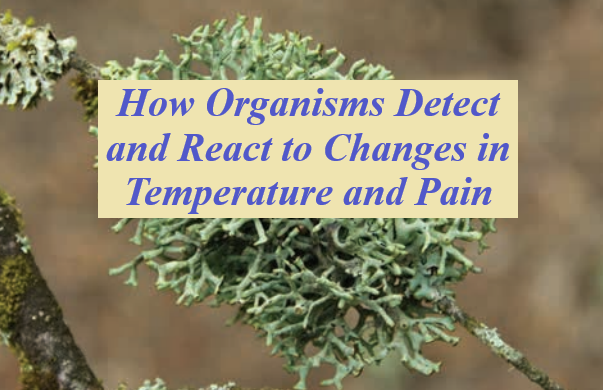How Organisms Detect and React to Changes in Temperature and Pain

How Organisms Detect and React to Changes in Temperature and Pain
How organisms react and detect temperature changes.
Thermoreceptors are regarded as nonspecialized sensory receptors (free nerve endings) that respond to changes in temperature.
There are two types, warm and cold receptors.
Invertebrates such as fleas and mosquitoes employ thermoreceptors to find their endothermic (“warm-blooded”) prey and hosts, birds and mammals.
When potential prey or a host is close, they detect body heat. Some thermoreceptors can detect changes of less than 1 degree Celsius.
Vertebrates have most of their thermoreceptors in the dermis of the skin.
When stimulated, Na+ and Ca2+ channels are opened to varying degrees, beginning the process of transduction.
Cold receptors are located more superficially, close to the epidermis, and far outnumber warm receptors. Warm receptors reside deeper in the skin.
In mammals, the cold and warm receptors are structurally distinct.
The cold receptors are associated with thinly myelinated neurons that increase conduction velocity, whereas the warm receptors are unmyelinated and conduct signals at a slower rate.
Thermoreceptors are meant to detect innocuous (harmless) changes in temperature. In humans, cold receptors fire most vigorously between 10°C and 25°C.
Warm receptors are most active between 25°C and 45°C.
If temperatures go far enough beyond these limits, they become potentially damaging, opening pain pathways.
Research indicates that this is due in part to the opening of TRP (transient receptor potential) ion channels, primarily for the flow of Na+ and Ca2+.
“Hot” peppers like jalapenos and habaneros give a sensation of heat because the chemical capsaicin activates the same receptors as a rise in temperature.
If capsaicin concentrate is high enough, pain will result.
Conversely, chemicals such as menthol, which activate cold receptors, leave you with a cooling sensation.
This is why throat lozenges and cough drops containing menthol have a “soothing” effect.
Some snakes use thermoreceptors for the detection of prey.
Pit vipers (including rattlesnakes) have pit organs located between the eye and the nostril.
These organs are wired into the visual processing center of the brain.
These snakes seem to be able not only to sense the temperature change but also to form a “thermal” image through infrared radiation.
That is, they can “see” heat.
This is a Marvelous example of sensory integration that affords them the ability to hunt in the dark.
Thermoreceptors are also found in the hypothalamus in the brains of birds and mammals.
This is to monitor the temperature of the circulating blood to ensure that core body temperature remains within a narrow homeostatic range.
As birds and mammals are endothermic, maintaining a constant body temperature is vital.
How organisms react and detect pain.
Receptors that transmit impulses perceived as pain in animals are called nociceptors (although a rough and nuanced translation, the term comes from the Latin nocere, which means “to hurt” or “to injure”).
Some of these receptors are free nerve endings found in the skin and other tissues and are stimulated by actual or potential tissue damage.
Overstimulation of other receptors, such as the cold and warm receptors discussed earlier, can send signals perceived as pain.
Vertebrate nociceptors communicate with other pain pathway sensory neurons using two main neurotransmitters, substance P and glutamate.
These carry the messages through the spinal cord and to the brain respectively.
When tissue is damaged, prostaglandins are released, increasing the sensitivity of nociceptors and subsequently the intensity of pain.
The analgesic effects of ibuprofen and aspirin are a function of their ability to inhibit the production of prostaglandins.
Mammals produce natural “painkillers” called endorphins and enkephalins.
These neurotransmitters inhibit the release of substance P by binding to opiate receptors in the spinal cord.
This same mechanism is responsible for the powerful analgesic effect of narcotics such as morphine and heroine.
Pharmacological manipulation of glutamate has proven more challenging as a potential pain inhibitor because of its role in learning, memory, and anxiety disorders.
From an evolutionary standpoint, pain is a good thing, as it indicates danger.
There is a medical condition known as congenital insensitivity to pain (CIP), in which affected people do not respond to tissue damage, as they cannot feel pain.
In most cases, it is caused by malfunctioning Na+ channels.
But some cases also involve an overproduction of endorphins.
Also Read:
- The Science of Taste, Smell, and pH
- What Predicts Student Achievement
- Memory and Learning. Mechanism of Alzheimer’s Disease Still a Mystery?
- Mechanism of Sleep and Language and Spatial Recognition.
Join Enlighten Knowledge WhatsApp platform.
Join Enlighten Knowledge Telegram platform.





